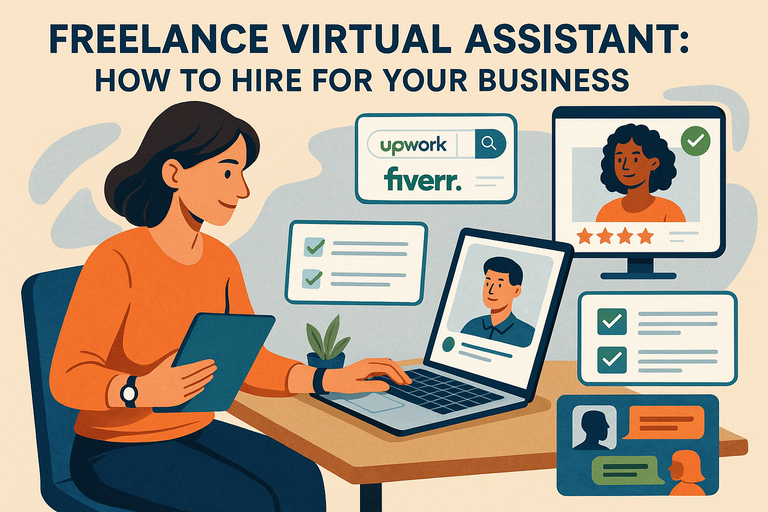Table of Contents
A freelance virtual assistant can be the secret weapon that helps you save time and keep your business running smoothly. Imagine having someone to handle emails, schedule meetings, or manage social media while you focus on growth.
The question is, how do you find and hire the right person who won’t just check off tasks but actually supports your goals? That’s exactly what we’ll explore step by step.
Why Your Business Needs a Freelance Virtual Assistant
Hiring a freelance virtual assistant isn’t just about getting help with admin tasks. It’s about freeing yourself from the daily grind so you can spend more time on strategy, growth, and the work you actually love.
Here’s why this role has become so essential for modern businesses.
Identify Time-Consuming Tasks That Hold You Back
If you’ve ever found yourself buried under emails, scheduling, or chasing invoices, you’re not alone. These tasks are necessary, but they rarely drive revenue directly.
I often tell people to make a list of everything they do in a week and highlight the tasks that someone else could realistically take over.
Typical time drains include:
- Managing your inbox and filtering important emails
- Scheduling appointments or coordinating calendars
- Posting updates on social media or tracking engagement
- Data entry, research, or maintaining spreadsheets
A freelance virtual assistant can take these off your plate. I believe the magic happens when you realize that every hour you spend on admin is an hour you’re not spending on client work or growing your business.
Even delegating just 10 hours a week can unlock a surprising amount of headspace and energy.
How Outsourcing Improves Productivity and Efficiency
Outsourcing isn’t about doing less—it’s about doing the right things. When you delegate recurring tasks to a freelance virtual assistant, you create a system where your time is focused on high-value work.
Think about it: If your hourly rate is $100, but you’re spending hours on $15 tasks, you’re not being efficient. Outsourcing allows you to re-align your time with the activities that actually generate growth.
I suggest starting small. For example, let a VA manage your social media scheduling through tools like Hootsuite.
From the dashboard, they can queue posts, track performance, and adjust schedules while you only focus on reviewing results. This way, the productivity gain is visible, and you can expand from there.
Cost Advantages of Hiring a Freelance Virtual Assistant
Here’s where it gets really interesting: Hiring a freelance virtual assistant is often cheaper than bringing on full-time staff. Y
ou avoid overhead like benefits, office space, and equipment. Instead, you pay only for the hours worked or tasks completed.
For small businesses or solopreneurs, that flexibility is priceless. You might spend $400–$800 a month on a VA for part-time support, compared to $3,000+ for a salaried assistant.
I’ve seen entrepreneurs who reinvested those savings into advertising or product development, essentially doubling their growth speed.
Outsourcing also gives you access to specialized skills without committing to long-term costs. Need help with bookkeeping this quarter? A freelance VA with accounting experience can step in, handle it, and step out when the project ends.
Flexibility Compared to In-House Staff
Traditional employees come with set schedules, fixed costs, and limited availability. A freelance virtual assistant offers flexibility that adapts to your needs.
You can hire someone for just five hours a week or scale up to thirty during busy seasons.
The beauty here is agility. For instance, if you run an eCommerce business, your VA can ramp up hours during holiday sales season, then scale back in quieter months.
This kind of flexibility keeps your costs aligned with your business cycle instead of draining cash during slow times.
On top of that, you’re not limited to local talent. You can find a VA in a different time zone who handles overnight tasks, meaning you wake up with work already done.
That’s something you simply can’t get with a 9–5 in-house assistant.
Defining the Role of a Freelance Virtual Assistant
Before you jump into hiring, it’s important to define exactly what you want a freelance virtual assistant to do. Their role can look very different depending on your business goals.
Different Types of Virtual Assistants and Their Skills
Not all virtual assistants are the same. Some specialize in general admin, while others bring niche expertise.
Here are the most common categories I’ve seen:
- Administrative VAs: Handle scheduling, email, and calendar management.
- Social Media VAs: Create posts, schedule content, and monitor engagement.
- Technical VAs: Manage websites, troubleshoot tools, or set up automations.
- Creative VAs: Handle content writing, graphic design, or presentation decks.
- Specialized VAs: Focus on areas like bookkeeping, eCommerce support, or customer service.
I recommend thinking of VAs as puzzle pieces. You don’t need someone who can do everything—you need the right piece that fits your current business stage.
Matching VA Skills With Your Business Goals
The key is alignment. If your goal is to grow your online presence, a social media VA makes more sense than a bookkeeping VA. On the flip side, if your problem is messy invoices, a VA with accounting software skills is the smarter choice.
I often suggest making a “skills map.” Write down the top three goals for your business in the next six months, then list the tasks that move you toward them.
Now, find a VA whose skills line up with those tasks. For example, if launching an email newsletter is a priority, look for a VA familiar with platforms like Mailerlite or AWeber.
This way, you’re not just hiring help—you’re hiring targeted support that pushes you closer to your actual goals.
Creating a Clear Scope of Work Before Hiring
One of the biggest mistakes I see is hiring a VA without defining what success looks like. A clear scope of work protects both you and the freelancer.
Here’s a simple framework I recommend:
- List the tasks you want delegated. Be specific: “Schedule three LinkedIn posts per week” is clearer than “help with social media.”
- Define the tools they’ll use. For instance: “Manage tasks inside Trello, update progress weekly.”
- Set communication standards. Decide whether you’ll check in via Slack, email, or weekly calls.
- Outline deliverables and deadlines. Example: “Monthly report due on the first Monday of each month.”
This upfront clarity eliminates confusion, builds trust, and keeps the relationship professional.
A well-written scope of work also makes your job posting more attractive to skilled VAs, because they’ll know exactly what they’re walking into.
Where to Find Reliable Freelance Virtual Assistants
Finding the right freelance virtual assistant is a little like dating—you need to know where to look and what you want before making a commitment.
Some places will give you quick access to talent, while others require more digging but may lead to better long-term fits.
Exploring Popular Freelance Platforms Like Upwork and Fiverr
Upwork and Fiverr are two of the most popular marketplaces for hiring freelance virtual assistants, and for good reason: they give you instant access to thousands of professionals worldwide.
Here’s how it works in practice:
- On Upwork, you post a job description and invite candidates. From the dashboard, you’ll see proposals with their hourly rates, skills, and client reviews. I suggest filtering applicants by verified work history and response time.
- On Fiverr, you search for pre-packaged “gigs.” For example, you might find a VA offering “20 hours of admin support” for a flat fee. I advise carefully reading the service descriptions and messaging the freelancer before booking.
Both platforms include built-in time tracking, payment protection, and dispute resolution.
While fees can add up (Upwork takes around 10%), the security and sheer choice are often worth it. The trick is to avoid picking the cheapest option—you usually get what you pay for.
Networking and Professional Communities for VAs
Sometimes the best freelance virtual assistant isn’t found on a big platform but through personal connections. Networking groups and communities can be goldmines because they’re filled with professionals who are actively engaged in their field.
For example:
- LinkedIn groups dedicated to VAs often have job boards or referral threads. Posting your role there can connect you to vetted assistants.
- Facebook communities exist where VAs share tips, resources, and openings. I’ve seen business owners post requests in groups and get dozens of qualified responses in hours.
- If you already know a fellow entrepreneur with a VA, don’t be shy about asking for a referral. Good VAs often work with multiple clients.
I believe this route works especially well when trust is important. Someone recommended through a community tends to care more about their reputation and long-term fit.
VA Agencies Versus Independent Freelancers
Another option is going through an agency that specializes in virtual assistants. Agencies often pre-screen candidates, handle contracts, and even replace your VA quickly if things don’t work out.
The trade-off is higher costs, since you’re paying for that layer of management.
Independent freelancers, on the other hand, usually offer more flexibility and lower rates. They may be easier to build a personal relationship with, which I find makes collaboration smoother over time.
Think of it like this:
- If you need reliability and scale, an agency might be best.
- If you value personal connection and budget control, go independent.
I suggest weighing how much time you want to spend managing the process yourself versus outsourcing the hassle of vetting. Both paths can lead to fantastic results—it just depends on your comfort level.
What to Look for When Evaluating Virtual Assistant Candidates
Once you’ve found potential freelance virtual assistants, the real work begins: figuring out who’s the right fit.
Hiring the wrong person wastes both money and energy, so taking time to evaluate candidates properly is worth every second.
Assessing Communication and Responsiveness
A VA’s ability to communicate well is just as important as their technical skills. If they’re slow to reply or unclear in their messages, you’ll constantly feel like you’re chasing them down.
Here’s how I test this upfront:
- Pay attention to how quickly they respond to your first message. Do they answer within 24 hours?
- Look at their tone. Are they polite, professional, and clear?
- During the interview, I ask situational questions like: “If a client emails you at 9 p.m. with an urgent request, how would you handle it?”
I suggest setting clear communication expectations right away.
For example: “I prefer Slack for quick updates and expect responses within one business day.” If a VA can’t agree to that, they’re probably not the right fit.
Checking Technical Skills and Software Knowledge
Your freelance virtual assistant needs to know the tools you rely on daily. Otherwise, you’ll waste time training them on basics.
I usually create a checklist of the apps I use—Google Workspace, Trello, Canva, or HubSpot—and ask candidates directly if they’ve used them before. Better yet, I request a mini demo.
For instance: “Can you show me how you’d schedule a post inside Buffer?” Watching them share their screen during a trial task reveals their comfort level fast.
Some VAs also bring specialized knowledge, like WordPress management, QuickBooks for bookkeeping, or CRM software. I believe aligning their technical skills with your business stack is one of the smartest moves you can make.
Importance of Portfolio and Client Reviews
A portfolio tells you what a VA can do, while client reviews tell you how they do it. Both matter.
For example, a VA might show you a portfolio of polished PowerPoint decks or social media calendars they’ve created. That demonstrates ability. But client reviews give insight into reliability: Do they meet deadlines? Are they easy to work with?
On platforms like Upwork, reviews are verified and often include metrics like job success rate.
I recommend looking for candidates with at least 90% positive feedback. If you’re hiring outside of platforms, ask for two references and actually call them—it’s amazing how much you can learn from a quick conversation.
Red Flags That Indicate a Poor Fit
It’s easy to get excited about a candidate who looks great on paper, but there are warning signs you shouldn’t ignore:
- Slow responses during the hiring process. If they can’t reply promptly now, it won’t improve later.
- Vague answers when asked about past experience. Skilled VAs can explain clearly what they’ve done.
- Overpromising (“I can handle anything you throw at me”). That usually means lack of focus.
- Inconsistent rates that change mid-discussion. Professional VAs are upfront about pricing.
I suggest trusting your gut here. If something feels off in your interactions, it’s better to walk away than force a bad fit. A strong working relationship with your VA should feel easy, not strained.
How to Write an Effective Job Description for a VA
A clear, well-written job description is the foundation for finding the right freelance virtual assistant. It filters out the wrong people and attracts candidates who are genuinely prepared to do the work.
Clearly Defining Tasks and Responsibilities
The biggest mistake I see? Writing vague descriptions like “Need help with admin tasks.” That tells a VA nothing about what you actually want. Instead, list out specific, repeatable tasks they’ll be handling.
For example:
- Manage inbox: Sort emails daily, flag urgent ones, draft replies.
- Calendar management: Schedule 3–5 client calls per week and send reminders.
- Social media: Use Buffer to schedule posts for LinkedIn every Monday and Wednesday.
Notice how each point is clear, measurable, and leaves no room for confusion. I suggest creating a list of “must-do” daily or weekly tasks alongside “occasional projects.” This way, your VA knows exactly what’s expected without guessing.
Highlighting Preferred Tools and Platforms
If your business relies on specific tools, call them out early. This helps you avoid hiring someone who’s never touched them before.
For instance, you could say:
- “Use Trello to track task progress.”
- “Create graphics in Canva using branded templates.”
- “Handle client communication in Slack, not email.”
Being upfront saves you from endless training later. I’ve hired VAs who already knew my software stack, and onboarding took days instead of weeks.
Setting Expectations Around Availability and Deadlines
A job description isn’t just about tasks—it’s about timing. Do you need them available during your business hours, or can they work asynchronously? Be clear.
Here’s how you could phrase it:
- “Available 10–15 hours per week, ideally between 9 a.m.–12 p.m. EST.”
- “All scheduled posts must be queued 48 hours in advance.”
- “Weekly progress report due every Friday at 5 p.m.”
This way, there are no surprises about when things get done. I suggest setting these boundaries upfront—it builds trust and keeps both sides accountable.
Interviewing Freelance Virtual Assistants Effectively
Once applications roll in, the interview is your chance to dig deeper and see how a candidate really thinks and works. Don’t just ask about experience—test it.
Asking Situational Questions to Test Problem-Solving
Situational questions reveal how someone reacts under pressure. I like to ask things such as:
- “If you’re juggling three urgent tasks and a client emails you with another urgent request, how do you prioritize?”
- “Tell me about a time you made a mistake for a client. How did you fix it?”
These aren’t trick questions. They’re designed to show whether a VA thinks logically and takes responsibility. I believe the best assistants are the ones who stay calm, own mistakes, and solve problems without panicking.
Evaluating Time Management and Multitasking Skills
A VA often handles multiple clients, so they need rock-solid time management. Ask them to walk you through how they organize their day. Some will mention tools like Asana or ClickUp. Others might use Google Calendar blocking.
I once asked a VA to screen-share and show me their task board. Within two minutes, I could see whether they actually practice what they preach. If their system looks chaotic, it’s a red flag. If it looks structured, it’s a green light.
Conducting Paid Test Projects for Practical Assessment
Here’s my golden rule: Never hire without a test project. A portfolio tells you what they’ve done before, but a test shows you how they’ll handle your work.
Keep it small but real, like:
- Drafting three social media posts using your brand voice.
- Scheduling a mock week of appointments in Google Calendar.
- Creating a sample report in Excel from a dataset you provide.
Pay them for their time, even if it’s just $20–$30. Not only is it fair, but it also shows how they value client relationships. I’ve found that a two-hour test project tells me more than a two-hour interview.
Setting Clear Terms and Agreements Before Hiring
This step is often skipped, but it’s crucial. Having clear agreements in place avoids misunderstandings and keeps your working relationship smooth.
Crafting a Simple Contract That Protects Both Parties
A contract doesn’t need to be a 20-page legal document. It just needs to outline:
- The scope of work (tasks, hours, deliverables).
- Payment terms (rate, due dates, method).
- Confidentiality (especially if they’ll access sensitive data).
- Termination clauses (how either party can exit).
I usually keep mine to 2–3 pages. A simple contract shows professionalism and gives both sides peace of mind.
Deciding on Payment Structure: Hourly vs. Project-Based
Payment is where many people get tripped up. Here’s how I decide:
- Hourly works best when tasks are ongoing but unpredictable (like inbox management).
- Project-based is smarter for one-off jobs (like creating a presentation deck).
I recommend asking candidates which they prefer. Some are more efficient on project rates, while others track time carefully. Either way, make sure the structure is clear to avoid disputes.
Setting Communication Channels and Reporting Systems
Even the best VA needs structure for communication. Decide on tools early, whether that’s Slack for quick chats, Trello for task updates, or weekly Zoom calls for deeper check-ins.
I’ve found that a simple system works best:
- Quick updates in Slack daily.
- Task progress in Trello updated weekly.
- One video call every two weeks for feedback.
This rhythm balances efficiency with accountability. Too much communication feels like micromanagement, while too little leads to missed deadlines.
Onboarding Your Freelance Virtual Assistant the Right Way
The first few weeks with a freelance virtual assistant set the tone for your entire working relationship. Onboarding doesn’t need to be complicated, but it does need to be intentional.
Creating a Smooth Orientation Process
When you bring on a new VA, think of it as welcoming them into your “digital office.” Even if you’re working remotely, orientation matters.
I recommend starting with a kickoff call. Walk them through your business goals, your workflow, and what success looks like in their role.
For example, if they’re managing your inbox, show them exactly how you want messages prioritized.
A simple onboarding checklist helps:
- Welcome call with introductions.
- Walkthrough of tools and daily routines.
- Share brand guidelines or tone of voice docs.
- Set expectations for communication and reporting.
This approach makes the VA feel supported from day one, which leads to faster results.
Providing Access to Tools and Resources Safely
Giving a VA access to your systems can feel scary. The key is setting up access safely.
For example, if you’re using Google Workspace, don’t just hand over your password. Instead, create a new user account with limited permissions.
If you use tools like LastPass, you can securely share logins without revealing the actual password.
When I onboarded my first VA, I created a “sandbox” Trello board just for practice. They could test features, try workflows, and make mistakes without affecting live projects. It reduced stress for both of us and sped up the learning curve.
Sharing Standard Operating Procedures (SOPs)
SOPs might sound corporate, but they’re simply step-by-step guides for repeatable tasks. A good SOP ensures consistency and saves you from answering the same questions over and over.
For example, you might write an SOP for scheduling blog posts:
- Step 1: Log into WordPress dashboard.
- Step 2: Click “Posts > Add New.”
- Step 3: Use the content template in Google Docs.
- Step 4: Set publish date and double-check formatting.
I advise starting small. Even documenting two or three core tasks can make a huge difference. Over time, you’ll build a library of SOPs that makes onboarding future VAs effortless.
Managing and Building a Strong Relationship With Your VA
Hiring a freelance virtual assistant isn’t just about tasks—it’s about building a partnership. The stronger your relationship, the more value you’ll get long-term.
Establishing Regular Check-Ins and Feedback Loops
A VA isn’t a “set it and forget it” hire. Regular check-ins keep you both aligned and prevent small issues from snowballing.
I suggest short weekly calls (15–20 minutes) to review tasks, celebrate wins, and discuss roadblocks. For quick updates, tools like Slack or Microsoft Teams are great.
Feedback should go both ways. Ask your VA what’s working and what isn’t. You’ll be surprised how often they come up with suggestions that improve your systems.
Encouraging Initiative and Proactive Problem-Solving
The best VAs don’t just follow instructions—they anticipate needs. But they’ll only feel comfortable taking initiative if you encourage it.
Here’s what I do: When a VA solves a problem without asking, I highlight it in our next call. For instance, one VA noticed I was missing deadlines for social posts and created a content calendar without being told. A small acknowledgment motivated them to keep stepping up.
I believe giving permission to “own” certain tasks transforms a VA from a helper into a true partner.
Recognizing Achievements to Build Long-Term Loyalty
Recognition goes a long way, especially with freelance VAs who might juggle multiple clients. A quick thank-you message, a bonus for great work, or even remembering their birthday can make them feel valued.
I once sent a $50 gift card to a VA after a particularly tough month, and their loyalty skyrocketed. Small gestures remind them they’re not just another contractor—they’re part of your team.
Measuring the Success of Your Freelance Virtual Assistant
It’s easy to hire a VA and hope for the best, but you need ways to measure whether they’re actually adding value to your business.
Setting Key Performance Indicators (KPIs)
KPIs give you objective ways to track progress. They don’t have to be complicated. Examples include:
- Number of tasks completed per week.
- Inbox response time (e.g., all priority emails handled within 24 hours).
- Social media posts scheduled vs. engagement levels.
I advise starting with 2–3 simple KPIs tied to your main goals. Too many metrics can feel overwhelming, but a few clear ones keep everyone focused.
Tracking Efficiency Gains and Time Saved
The whole point of hiring a VA is to free up your time. Track how many hours you’re saving each week and how you’re using that time.
Here’s a simple trick: Before hiring a VA, log your weekly hours on admin tasks. After a month of working with them, compare. If you were spending 15 hours a week on email and now it’s only 5, that’s a measurable win.
Some clients even calculate ROI: If your freed-up time lets you bill two extra hours at $100/hour, that’s $800 of extra revenue per month from a $400 VA investment.
Knowing When It’s Time to Scale Up Support
At some point, you might realize your VA is maxed out. Signs include:
- Deadlines slipping because they’re overloaded.
- You still handling tasks you’d rather delegate.
- Business growth outpacing their current scope.
I recommend scaling gradually—maybe increasing hours by 5–10 per week or hiring a second VA with a different specialty.
For example, your admin VA handles scheduling, while a new VA focuses on social media or customer support.
Scaling smart ensures you always have the right level of support without burning out your VA or yourself.






